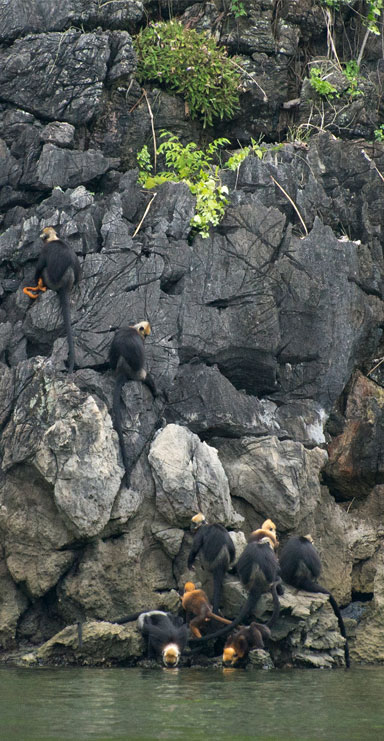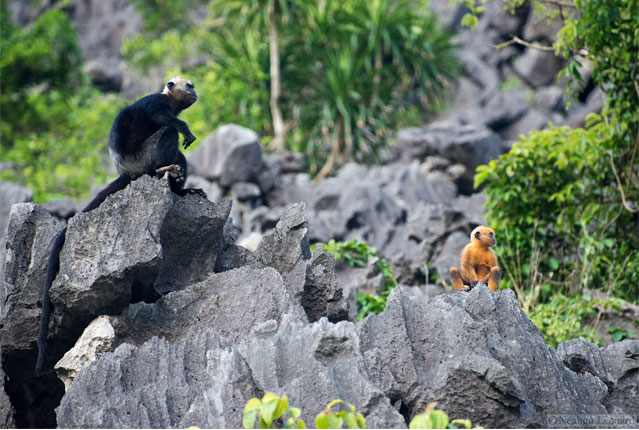- Vietnam’s Cat Ba langur is an island-dwelling primate adapted superbly to a harsh landscape marked by razor-sharp bedrock, sheer limestone escarpments and sparse freshwater.
- Neahga Leonard’s research team is engaging local communities to curb poaching, and helped establish a langur sanctuary in Cat Ba National Park.
- Up to $100,000 spent annually has made a difference — the number of Cat Ba langurs, which was plummeting for decades, is now on the rise.

Life isn’t easy on Cat Ba Island. Situated about 50 kilometers (31 miles) east of Haiphong — Vietnam’s third-biggest city — Cat Ba is a jumble of limestone boulders, coral terraces and mangrove forests. The landscape is slashed by deep crevices, marked by dangerous cliffs and covered in dense vegetation.
The island’s only source of freshwater comes from two shallow ponds, both of which disappear in dry times. Rain, meanwhile, has pummeled the rocks for millennia, creating hazardous beds of limestone needles with saw-toothed edges — blood is more common than freshwater on Cat Ba.
Despite this seemingly inhospitable environment, Cat Ba and its surrounding waters — all part of the Cat Ba Archipelago, a UNESCO World Heritage Site — are home to more than 1,500 species of flora and fauna, dozens of which exist nowhere else on Earth. These include the southern serow (Naemorhaedus sumatraensis), a species of goat-antelope; the rhesus macaque (Macaca mulatta); leopard cat (Prionailurus bengalensis); black giant squirrel (Ratufa bicolor); and civet cat (Viverricula indica, Paradoxurus hermaphroditus), along with 27 species of bats and a wide range of unique ocean life.

Also part of that incredible biodiversity is one of the world’s most endangered primates, the Cat Ba langur (Trachypithecus poliocephalus poliocephalus).
Don’t be surprised if you’ve never heard of the Cat Ba langur. Few people have. Fewer still get a chance to see these elusive, black-furred monkeys, which are uniquely adapted to the rocky landscape and spend much of their time hiding from the pounding rains in limestone caves.
That doesn’t mean they were always hard to find. The species nearly went extinct 20 years ago due to rampant poaching for traditional medicine and from “sport” hunting by tourists visiting the island. The population in the 1960s was estimated at over 2,500 animals. By 2000, the estimate had plummeted to about fifty.

But the new millennium also marked a milestone. That was the year Germany’s Allwetterzoo Münster and other organizations established the Cat Ba Langur Conservation Project, a long-term effort to prevent the species from going extinct. The CBLCP employs four full-time people on the island.
Preserving the langur wasn’t easy. The first step was to put a stop to hunting, which removed a few langurs from the ever-shrinking population each year. The CBLCP — still the only organization solely devoted to protecting the species — started monitoring the langurs and protecting the largest groups. It also worked to strengthen protections within Cat Ba National Park — hiring guards and increasing staff capacity, meeting with local citizens, and establishing an official langur sanctuary within the preserve.

The efforts worked, just in time. “We got the hunting to stop, but the low point came in 2003 with only 40 confirmed animals on the island,” says Neahga Leonard, current manager for the CBLCP.
The population has slowly grown since, and is currently estimated at about 67 animals in a few isolated sub-populations. That includes a few newborns — flamboyantly orange for the first four months of their lives — which joined the species earlier this year. “This is a great success,” he said, “but it’s obviously still a terribly small number of animals to represent an entire species.”
A unique species (that’s still a little confusing)
Besides its rarity, there’s another reason why few people know about the Cat Ba langur: it has often been confused with other nearby mainland langur species.
In the past, it has been classified as its own species, a subspecies of one or two other species, and even simply as an albino variant of the François’ langur (T. francoisi). However, the most recent edition of the biennial Primates in Peril report, which catalogs the world’s 25 most endangered primate species, lists the Cat Ba langur as a separate species (T. poliocephalus), a designation that is gaining scientific acceptance.
“It looks like the Cat Ba langur will soon be officially recognized as an independent species,” Leonard reports with satisfaction.

All of this confusion may have delayed conservation efforts, especially at the local level, because people didn’t think the Cat Ba langur was unique. That’s now changed, says Leonard: “Everyone likes to have ‘something special’ that no one else has.”
The Cat Ba langur doesn’t look too much different from other Vietnamese langurs — other than a few tufts of yellow along the cheeks, crown and neck. Its behavior, however, stands apart.
“They sometimes come down to the seaside to drink small amounts of salt water,” Leonard says. “We don’t know why, and it seems unlikely that they need the additional salt, as the current population lives near the sea and eats vegetation that regularly gets sprayed by windblown seawater.” On Cat Ba the langurs get most of their fluids from vegetation and pockets of trapped rainwater.

The species has also specially adapted to the harsh environment. They eat a wide range of foods, including shoots, flowers, bark and fruit, some of which contain high levels of fiber and tannic acid and many of which carry substances that would be poisonous to other species, including humans. Leonard also reports the monkeys as seeming to have a preference for the steep cliffs that embody the most extreme elements of the island. They sleep under protected overhangs and in caves an average of 42 meters (137 feet) above the ground or water. Many places where the last langurs live simply can’t be reached by humans on foot.
Hard work to protect the remaining Cat Ba langurs
So how does the Cat Ba Langur Conservation Project manage to help a species that requires acrobatic agility to visit its habitat?
It’s not easy. The island itself is hard to traverse. “The terrain will absolutely shred the clothes and flesh of anyone who is unwary,” Leonard says. “Careful footing and deliberate movement is critical when on land — if you fall, there are many ways of being injured.”
He describes one recent survey where it took an experienced group of people five hours to travel one and a half kilometers, less than a mile. “During that time we had to make a path through a stand of a spiny plant in the Euphorbiaceae genus, with large spikes and toxic sap; avoid numerous sinkholes, including one with the most shallow ledge being some four meters down; navigate narrow cliff edges; and find footing in organic detritus — making what appeared to be a smooth portion of ground over what was actually a honeycomb of sharp spikes and deep holes in the limestone — like a naturally occurring field of pit-traps.”

Another survey involved crossing what Leonard describes as a set of rocks that looked like Mordor from the Lord of the Rings movies. “My senior conservation officer was crossing from one valley to the next over a steep slope that required a delicate passage around one of these precariously balanced boulders,” he reports. “At one point he nearly lost his footing, grabbed the rock crown for stability, and the entire block of rock twisted in his grasp, fortunately not falling, taking him and the rest of the team with him.”
These terrestrial dangers have prompted the scientists to find other ways to observe the langurs. “Most of our fieldwork is done from boats,” Leonard says. Even that is rife with dangers. “The coastline is complicated, filled with islands, steep-sided fjords, and convoluted peninsulas. In many places, the cliffs fall sheer for 40-50 meters (130-164 feet), and are undercut where they meet the water. Many areas have shallow water and are not accessible by boat during low tide.” Confounding matters further are the Gulf of Tonkin’s extreme once-a-day tidal flows, which raise or lower the water up to 3 meters (10 feet). Low tides often bring encounters with barely submerged rocks. No matter what time they travel, they encounter drifting debris from the “astounding amount of pollution in the waters.”
Even by boat, it’s not easy to observe the animals. “We can’t follow them everywhere,” he says. The monkeys dart around the cliffs or trees, partially camouflaged by their fur. “Even when viewed up close, individuals are extremely difficult to tell apart. When the langurs are in vegetation, even [their] presence is difficult to confirm, as errant breezes look much like a langur changing position.” Even experienced observers sometimes see what they think is a langur only to realize that it’s a giant black squirrel “We often joke that a giant black squirrel is worth half a langur,” he says.

The CBLCP has an annual budget of about US $80-100,000, most of which is provided by Allwetterzoo Münster. Periodic private donations help supplement that funding. “We always struggle to provide equipment and capacity building training to our local partners within the National Park and in the villages we work with,” Leonard says. “Things like waterproof binoculars, GPS units, waterproof notebooks, small tough cameras, and the like, are always needed, as they are easily damaged in this environment.”
Leonard says he was attracted to working with the Cat Ba langur because of its rarity and endemism, as well as by the CBLCP’s ecosystem-wide approach to conservation. “The holistic approach here incorporates not just conservation of the individual species, but includes the habitat and larger biodiversity of the island, and does so via direct engagement with local community members, National Park staff and Vietnamese politicians,” he explains.
It doesn’t hurt that the island itself is pretty magical in appearance — if a bit dangerous.
A somewhat bright outlook
What does the future look like for the Cat Ba langur? The biggest threat for the species today is that hunting for a variety of other animals remains prevalent on the island among its 16,300 inhabitants. This could result in langurs getting caught in traps or otherwise accidentally killed by hunters targeting other species. “Langur hunting has completely stopped, but poaching for other animals is still quite common and we are trying to get this to stop as well,” Leonard says.

Meanwhile, the population of langurs continues its slow increase. This year’s baby boom isn’t likely to be repeated too soon, because females can only give birth every 2 to 3 years, and any newborns will require 4 to 6 years to reach sexual maturity. Scientists expect to see a semi-cyclical population growth pattern, with a handful of new langurs born every few years.
Despite the slow growth rate and the still-terribly low number of Cat Ba langurs, Leonard feels optimistic regarding the species’ fate. “The population has nearly doubled since the low point,” he says. That’s something to be celebrated, even for a species that few people even realize exists.
